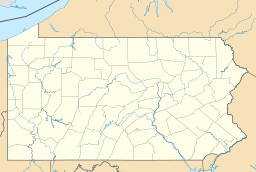Little Blue Run Lake facts for kids
Quick facts for kids Little Blue Run Lake |
|
|---|---|

NASA image of Little Blue Run from 2002
|
|
| Location | Pennsylvania, West Virginia |
| Coordinates | 40°37′32″N 80°30′47″W / 40.62556°N 80.51306°W |
| Lake type | artificial lake |
| Basin countries | United States |
Little Blue Run Lake, also called Little Blue Run, is the largest place in the United States where coal ash is stored. Coal ash is a leftover material from burning coal to make electricity. The company FirstEnergy owns this site. It is located in Western Pennsylvania and parts of West Virginia. Over time, billions of gallons of coal waste have been put into this lake.
Contents
About Little Blue Run Lake
This artificial lake was finished in 1975. It is found in both Beaver County, Pennsylvania and Hancock County, West Virginia. The company FirstEnergy owns the lake. Before the lake was built, the power company told local people it would be a fun place for boating and recreation.
The lake covers about 1,900 acres (770 ha) of land. A very large rock-and-earth dam holds the waste inside the lake. This dam is about 400-foot (120 m) tall and 2,200-foot (670 m) wide. It helps stop the waste from escaping.
The Dam's Safety Rating
The dam at Little Blue Run Lake has a "high hazard" rating. This means if the dam were to break, it could cause serious harm or even loss of life. Some natural valleys in the area were filled with a mix of coal ash and water. This mix, called coal slurry, was piped into the lake from the Bruce Mansfield Power Plant in Shippingport.
Environmental Concerns
The lake holds about 20 billion US gallons (7.6×1010 litres; 1.7×1010 imperial gallons) of coal ash and waste from smokestacks. The northern edge of the lake is very close to the Ohio River. This river provides drinking water for more than three million people.
Pollution Risks and Rules
The Pennsylvania Department of Environmental Protection (PADEP) believes that if the dam failed, it could affect 50,000 people. Because of this, they have ordered that no more coal ash can be added to the lake after 2016. In 2015, a news report said that harmful pollutants were leaking from the lake into the nearby community.
The Little Blue Run Coal Ash Impoundment does not have a special lining at the bottom. Over time, this has caused pollution to leak into the ground and surface water. Local families use this water for drinking, cooking, and bathing. Some people living nearby are worried about their health because of this pollution. Families also worry about toxic dust in the air. They also complain about a strong smell like rotten eggs, which comes from a gas called hydrogen sulfide (H
2S).


